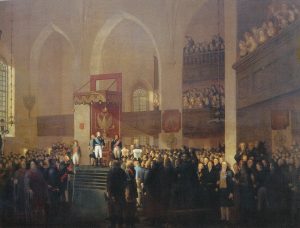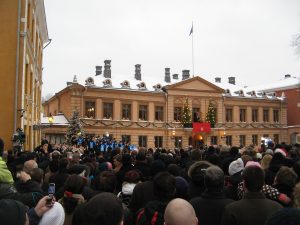The year of the 500th anniversary of the Reformation is also the year of the 100th anniversary of Finnish independence. How much did the Reformation shape Finnish culture and society?
The Reformation gave rise to written Finnish, having thus a considerable role in the making of Finland. As the printed works of Mikael Agricola spread in multiple copies throughout the country, they formed a basis for a standard written language.
A common written language made possible a shared identity between the different regions of Finland. Writing also expanded the possibilities of the language by creating new vocabulary and concepts. First, it enabled one to speak and write about God and theology in Finnish, later about science, philosophy, ideologies and politics.
Lutheranism also came to be considered a central feature of being Finnish. During the period of Lutheran orthodoxy in the 17th century, Lutheranism became the only permitted religion. Virtually no other religions were left anywhere in the kingdom.

Alexander I, Emperor of Russia, presiding over the Diet of Porvoo in 1809, where the Emperor conceded to Finland the right to profess the Lutheran faith. Painting by Emanuel Thelning. Wikimedia Commons.
When Finland was annexed to the Russian Empire in 1809 following the Finnish War (part of the Napoleonic Wars), Finnish people feared a forced conversion to Orthodoxy. The Emperor Alexander I, however, conceded to Finland the right to profess the Lutheran faith. Later, in the wake of nationalism, the Lutheran faith, together with the Finnish language, was then used to define how Finland was different from the rest of the Russian Empire.
Finland gained independence in 1917, and in 1923 a law permitting freedom of religion was enacted thus enabling individuals to leave the Church. However, the majority of the population remained Lutheran, and in 2016, 71.9 per cent of the population are still members of the Church. Even if today many are not very religious, nonetheless, Lutheranism is still a deep undercurrent in the Finnish society, even among non-religious people.
In 2017, as we are celebrating the double anniversaries of the Reformation and of Finnish independence, Finland can be proud of its Lutheran roots. Finland is a welfare state, in which public services ensure medical treatment and social security for everyone. Moreover, the Finnish educational system is today renowned as one of the best in the world. These are indirect consequences of the Reformation: Lutheranism emphasised the common responsibility of the society to take care of those in need, and the catechumenal teaching formed a basis for the educational system of Finland.
Today, Finland is a part of the European Union and of the globalised world, and we face global problems which we cannot fight on our own. Therefore, we have chosen the word “Yhdessä”, “Together”, to be the official theme for the anniversary of Finnish independence. Because it is together, or not at all, that we will solve the acute problems of our shared planet and of our shared humanity. And it is together with the rest of the world that we must build a better future for our children.
Ein feste Burg ist unser Gott
A Mighty Fortress Is Our God
The Proclamation of the Christmas Peace in Turku in 2009, where the hymn “A Mighty Fortress is our Lord” is sung every year. By Palosirkka, original by LPfi. Wikimedia Commons. CC BY-SA 3.0.The hymn “A Mighty Fortress Is Our God” illustrates very well how the Lutheran Faith and Finnish identity have been intertwined in Finland. The hymn is well-known also elsewhere in the Protestant world, but in Finland it has gained the status of “national hymn”. It has been sung in the fateful hours of the nation, as in 1939, when the delegation of Finland was leaving for Moscow for the peace negotiations with the Soviet Union. The hymn is still sung every Christmas during the proclamation of the Christmas peace, together with the national anthem of Finland.

Leave a Reply